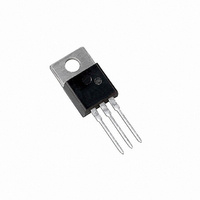MLP1N06CL ON Semiconductor, MLP1N06CL Datasheet - Page 3

MLP1N06CL
Manufacturer Part Number
MLP1N06CL
Description
MOSFET N-CH 1A 62V TO-220AB
Manufacturer
ON Semiconductor
Series
SMARTDISCRETES™r
Type
Low Sider
Datasheet
1.MLP1N06CL.pdf
(8 pages)
Specifications of MLP1N06CL
Input Type
Non-Inverting
Number Of Outputs
1
Operating Temperature
-50°C ~ 150°C
Mounting Type
Through Hole
Package / Case
TO-220-3 (Straight Leads)
Configuration
Single
Transistor Polarity
N-Channel
Resistance Drain-source Rds (on)
0.75 Ohms
Forward Transconductance Gfs (max / Min)
1.4 S
Drain-source Breakdown Voltage
59 V
Gate-source Breakdown Voltage
+/- 10 V
Continuous Drain Current
1 A
Power Dissipation
40 W
Maximum Operating Temperature
+ 150 C
Mounting Style
Through Hole
Minimum Operating Temperature
- 40 C
Lead Free Status / RoHS Status
Contains lead / RoHS non-compliant
Voltage - Supply
-
Current - Output / Channel
-
On-state Resistance
-
Current - Peak Output
-
Lead Free Status / Rohs Status
No
Available stocks
Company
Part Number
Manufacturer
Quantity
Price
Company:
Part Number:
MLP1N06CL
Manufacturer:
ON
Quantity:
12 500
Company:
Part Number:
MLP1N06CLG
Manufacturer:
XILINX
Quantity:
600
THE SMARTDISCRETES CONCEPT
and passive elements can be obtained that provide on–chip
protection to the basic power device. Such elements require
only a small increase in silicon area and/or the addition of one
masking layer to the process. The resulting device exhibits
significant improvements in ruggedness and reliability as
well as system cost reduction. The SMARTDISCRETES
device functions can now provide an economical alternative
to smart power ICs for power applications requiring low
on–resistance, high voltage and high current.
rugged power switching device with short circuit protection
that can be directly interfaced to a microcontroller unit
(MCU). Ideal applications include automotive fuel injector
driver, incandescent lamp driver or other applications where
a high in–rush current or a shorted load condition could occur.
OPERATION IN THE CURRENT LIMIT MODE
withstand the current stress resulting from a shorted load
before its maximum junction temperature is exceeded is
dependent upon a number of factors that include the amount
of heatsinking that is provided, the size or rating of the
device, its initial junction temperature, and the supply
voltage. Without some form of current limiting, a shorted
load can raise a device’s junction temperature beyond the
maximum rated operating temperature in only a few
milliseconds.
shorted load powered by an automotive battery (10 to 14
Volts) for almost a second if its initial operating temperature
is under 100 C. For longer periods of operation in the
current–limited mode, device heatsinking can extend
operation from several seconds to indefinitely depending on
the amount of heatsinking provided.
From a standard power MOSFET process, several active
These devices are designed for applications that require a
The amount of time that an unprotected device can
Even with no heatsink, the MLP1N06CL can withstand a
Figure 1. Output Characteristics
http://onsemi.com
MLP1N06CL
3
SHORT CIRCUIT PROTECTION AND THE EFFECT OF
TEMPERATURE
integrated means of protecting the MOSFET component
from high in–rush current or a shorted load. As shown in the
schematic diagram, the current limiting feature is provided
by an NPN transistor and integral resistors R1 and R2. R2
senses the current through the MOSFET and forward biases
the NPN transistor’s base as the current increases. As the
NPN turns on, it begins to pull gate drive current through R1,
dropping the gate drive voltage across it, and thus lowering
the voltage across the gate–to–source of the power
MOSFET and limiting the current. The current limit is
temperature dependent as shown in Figure 3, and decreases
from about 2.3 Amps at 25 C to about 1.3 Amps at 150 C.
dissipate power during a shorted load condition, it is
important to provide sufficient heatsinking to limit the
device junction temperature to a maximum of 150 C.
to the power MOSFET’s on–resistance, but the effect of
temperature on the combination is less than on a standard
MOSFET due to the lower temperature coefficient of R2.
The on–resistance variation with temperature for gate
voltages of 4 and 5 Volts is shown in Figure 5.
source provide ESD protection to greater than 2 kV, HBM.
This on–chip protection feature eliminates the need for an
external Zener diode for systems with potentially heavy line
transients.
The on–chip circuitry of the MLP1N06CL offers an
Since the MLP1N06CL continues to conduct current and
The metal current sense resistor R2 adds about 0.4 ohms
Back–to–back polysilicon diodes between gate and
Figure 2. Transfer Function








